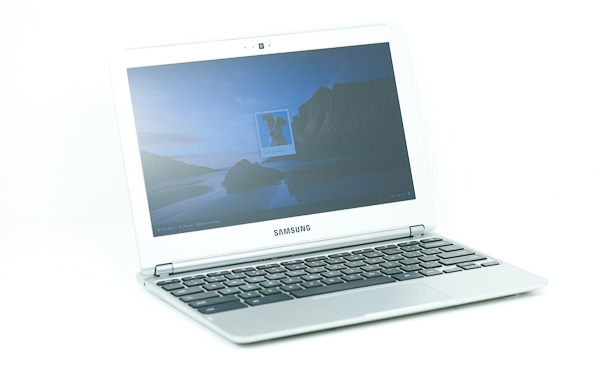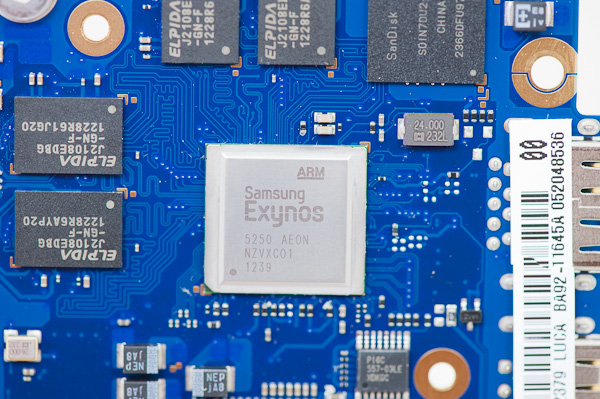Samsung Chromebook (XE303) Review: Testing ARM's Cortex A15
by Anand Lal Shimpi on October 31, 2012 9:00 AM ESTGoogle announced the Chrome OS project two years ago, and with it came the first Chromebook: the CR-48. The Chrome OS concept seemed revolutionary at the time. In 2010 we were well into the latest round of questioning whether today's PCs were fast enough. The Ultrabook revolution hadn't yet begun, and the iPad was starting to gain momentum. Capitalizing on the market being flooded with poor quality, yet affordable PC notebooks that still struggled with the same virus/malware issues they'd been facing for years, Google took the opportunity to attempt to revolutionize the PC OS.
Chrome OS was that attempt at a revolution. As an OS built around a web browser, Chrome OS offered many of the advantages that the Chrome browser itself brought to the table: sandboxing, guest mode and constant/painless updates. All user data is encrypted on the drive by default. Security was and remains a major feature of Chrome OS.
Google's revolution extended to hardware as well. The Cr-48 notebook delivered a good keyboard, trackpad and solid state storage. Future Chromebooks would do the same. While the price points of these machines (<$500) kept ultra high resolution IPS displays out of the bill of materials, Google promised good build quality and solid state storage - two things you couldn't find in cheap notebooks of the time.
Since then, some of the traditional PC makers have woken up. Although confined to the $999+ price point, we're finally seeing attention paid to build quality, display quality and storage performance. Over the next couple of years there's going to be increased focus on bringing those premium features down to sub $700 price points.
For Chrome OS and Google's Chromebooks to remain relevant, they also had to move down the pricing stack. With its most recent announcement, Google has done just that. The new Chromebook (Samsung XE303C12) is priced at $249, while maintaining much of what made its predecessors interesting.
Even more interesting than its aggressive price point is the choice of SoC inside Google's new Chromebook: Samsung's Exynos 5 Dual, featuring two ARM Cortex A15 CPU cores. This move makes the new Chromebook the very first non-x86 machine to ship with Chrome OS. Given that I also happen to have a dual-core Atom based Chromebook from 2011, the new Exynos 5 based machine gave me a unique opportunity to get a preview of how ARM's next-generation CPU core would stack up against Atom.













149 Comments
View All Comments
wumpus - Wednesday, October 31, 2012 - link
I would assume that the real issue is if you can wipe chromeOS and replace with the linux of your choice. By the security choices you list, I wouldn't be using any type of windows box. From the comments below, there doesn't appear to be a "plug a USB stick in and hit a button" linux disto yet.jeffkro - Wednesday, October 31, 2012 - link
Look into ixquick if you are worried about search privacy.jeffkro - Wednesday, October 31, 2012 - link
"I'm not sure, but I think there's no choice for editing text apart from Google Docs?"If you are really tied to MS office you can use MS's cloud based office suite.
jjj - Wednesday, October 31, 2012 - link
Nice perf numbers.On power consumption both the software and the hardware are a lot different form a phone so maybe it's not as bad as you think.Now all we need is quad A15 :D (might be doable in tablets/notebooks with bigLITTLE or Nvidia's 4+1 even on 28nm)
Roland00Address - Wednesday, October 31, 2012 - link
It will be 4 A15 cores plus a low power companion core. Who knows when it will be actually in devices.I have not heard any announcements for quad core A15 from other sources (such as Samsung) that said it is going to happen sometime even if it has not been announced.
Jorange - Wednesday, October 31, 2012 - link
Excellent I've been waiting for this review. Exynos 5250 does seem a power hungry chap, which kinda destroys my hopes for a quad-core 5450 / Mali T658 in the next Galaxy phone, unless Samsung move to a new node. There is mention of 28nm process on Samsung's foundry site, combined with Big.little maybe my dreams are alive.Anand, any news when Samsung will adopt a new process node, and will it be 28nm or 22nm?
Work is already underway to port Ubuntu to it:)
http://www.omgubuntu.co.uk/2012/10/ubuntu-12-04-up...
amdwilliam1985 - Wednesday, October 31, 2012 - link
I share your excitement, I have SGS3 and I'm so looking forward to SGS4 and what it can bring to the table. Hopefully some sort of big.LITTLE design to lower the power draw, also there is a trend of bigger battery, hopefully the trend continues without much increasing in the physical size.Krysto - Thursday, November 1, 2012 - link
Why? Samsung will do it just like Nvidia with Tegra 4, and put 1 or 2 Cortex A7 chips next to the A15's, which will handle 80% of the tasks.Aenean144 - Thursday, November 1, 2012 - link
I'm curious how big.LITTLE is going to work in practice. The auto switching between discrete graphics and integrated graphics on laptops may give us a clue on how well it works.Hitting 9 W peak at 1.7 GHz? That's Haswell territory, and I'd surmise Haswell will crush any ARM, even the 64 bit ones in 2014, with a 10 W TDP envelope.
Secondarily, either Samsung is binning some low power parts for the Nexus 10 and prospective smartphones, or they have to downclock. The big question would be how much would they have to downclock.
On to the Nexus 10 analysis.
Kevin G - Wednesday, October 31, 2012 - link
Very respectable performance from the Cortex A15. It'll be interesting to see how it'll fair in a smart phone but the bar has been set.